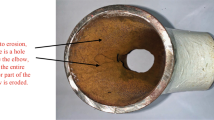Abstract
A procedure for revealing factors causing damage to metal and the dominating mechanism through which this damage occurs that was developed earlier is applied for substantiating the operating conditions of valves with D nom = 800 mm installed in the multiple forced circulation loop of power units at nuclear power stations equipped with RBMK-1000 reactors under which their resistance to erosion is ensured. Operating conditions under which cavitation erosion may occur are established, and practical proposals on how to prevent damage to the metal of a throttle-control valve’s body are presented.
Similar content being viewed by others
References
V. N. Lovchev, “Measures for Achieving Operational Resistance of NPS Equipment and Pipelines to Erosion-Corrosion Wear,” Rosenergoatom, No. 6, 48–51 (2007).
G. V. Tomarov, A. A. Shipkov, V. N. Semenov, et al., “Achieving Better Efficiency of Methods for Examining the State of Main Metal of Equipment and Pipelines at Nuclear Power Stations,” Tyazh. Mashinostr., No. 1, 12–15 (2007).
G. V. Tomarov, Yu. V. Petrov, A. A. Shipkov, et al. “Making the Tube System’s Fitting Parts of the Low-Pressure Evaporators Used in the Heat-Recovery Boilers of Combined-Cycle Units More Resistant to Erosion-Corrosion Wear During Operation,” Teploenergetika, No. 2, 56–61 (2008) [Therm. Eng., No. 2 (2008)].
O. A. Povarov, G. V. Tomarov, E. V. Velichko, et al., “Erosion-Corrosion Wear of the Metal of Elements Used in Turbine Units of Thermal and Nuclear Power Stations: An Overview,” Energ. Mashinostr., Ser. 3, issue 12 (1991).
H. G. Heitmann and W. Kastner, “Erosion-Corrosion in Waterstream Cycles — Causes and Corrective Measures,” VGB Kraftwerkstechnik 2(3), 211–219 (1982).
H. Keller, “Erosion-Korrosion on NaBLampfturbine,” VGB Kraftwerkstechnik, No. 5, 292–295 (1974).
G. V. Tomarov and A. A. Shipkov, “Simulation of Physicochemical Processes of Erosion-Corrosion of Metals in Two-Phase Flows,” Telpoenergetika, No. 7, 7–17 (2002) [Therm. Eng., No. 7 (2002)].
V. I. Zarembo, V. G. Kritskii, L. V. Puchkov, and A. A. Slobodov, “Solubility of Magnetite under the Conditions of Reducing Medium in Water Circulating in NPS Process Circuits at Elevated Temperature,” At. Energ. 64(3) (1988).
P. Tremine, R. Massow, and G. Sherman, “A Calculation of Gibbs Free Energies for Ferrous Ions and the Solubility of Magnetite in H2O and D2O to 300°C,” Termochemics Acta 19, 287–300 (1977).
F. Sweeton and C. Baes, “The Solubility of Magnetite and Hydrolysis of Fercoul Ion in Aqueous Solutions at Elevated Temperatures,” J. Chem. Thermodyn. 2(4), 479–500 (1970).
V. I. Zarembo, V. G. Kritskii, A. A. Slobodov, and L.V. Puchkov, “The Solubility of Magnetite in the Coolant of a Nuclear Power Station Equipped with a Boiling Water Reactor,” At. Energ. 65(1) (1988).
V. M. Budov, Pumps for Nuclear Power Stations (Energoatomizdat, Moscow, 1986) [in Russian].
A. V. Ratner and V. G. Zelenskii, Erosion of Materials of Thermal Power Equipment (Energiya, Moscow-Leningrad, 1966) [in Russian].
Author information
Authors and Affiliations
Additional information
Original Russian Text © G.V. Tomarov, A.A. Shipkov, N.S. Koreshkova, 2010, published in Teploenergetika.
Rights and permissions
About this article
Cite this article
Tomarov, G.V., Shipkov, A.A. & Koreshkova, N.S. Calculated and experimental substantiation of operating conditions under which adequate erosion resistance of valves used in power units at nuclear power stations is ensured. Therm. Eng. 57, 382–390 (2010). https://doi.org/10.1134/S0040601510050046
Published:
Issue Date:
DOI: https://doi.org/10.1134/S0040601510050046




